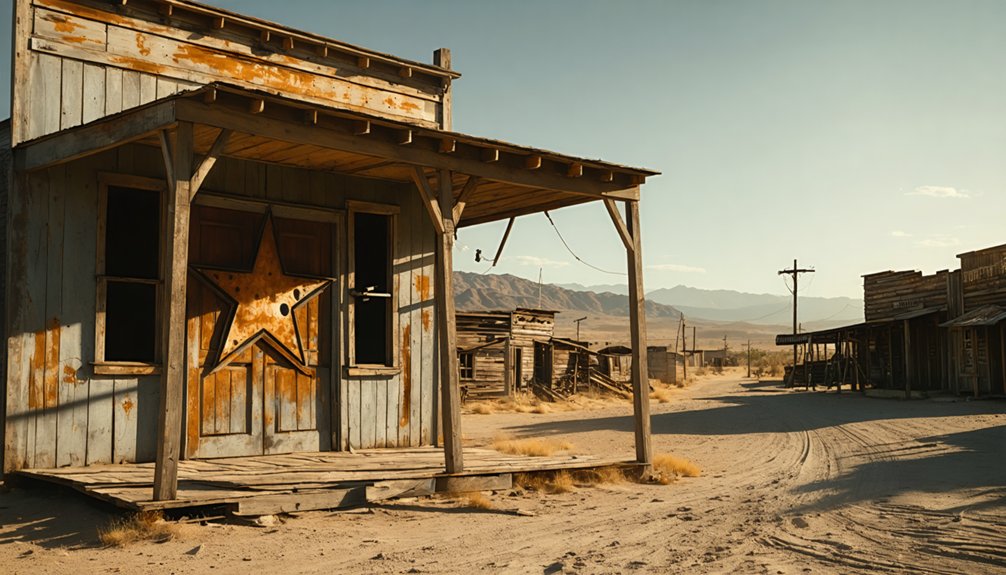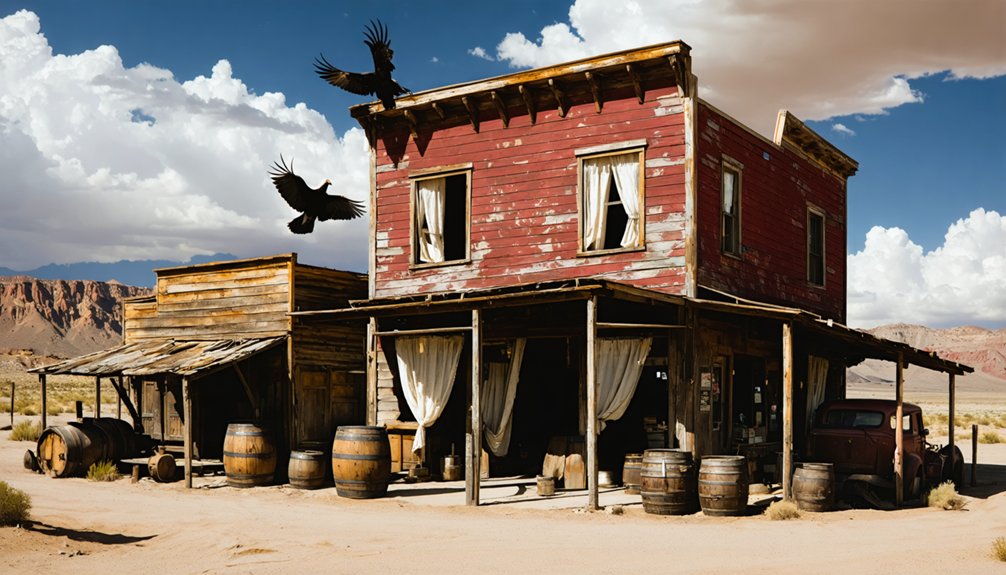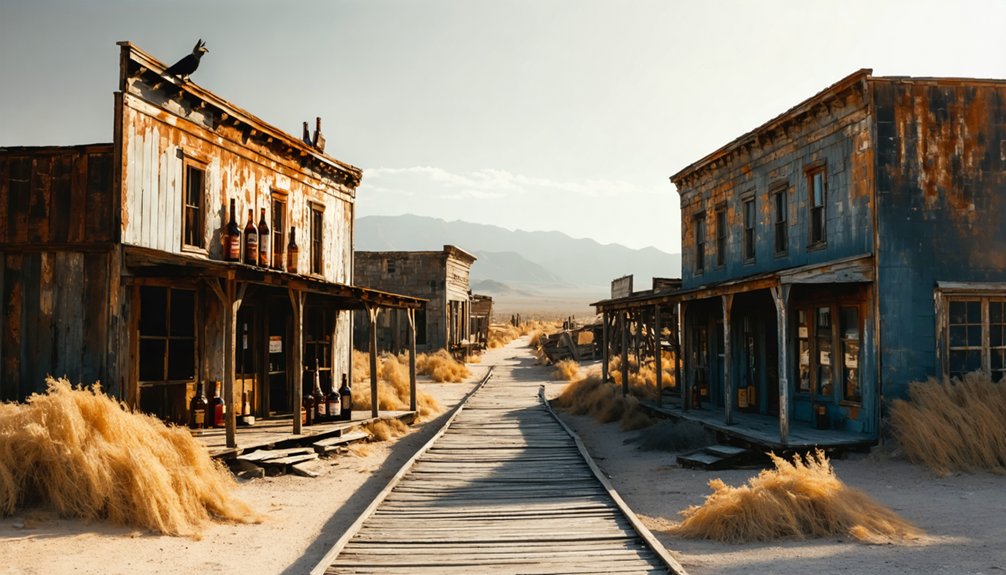Lookout City, established in 1875 after silver-lead ore discovery, briefly thrived as a boomtown with saloons, stores, and 50+ dwellings near Death Valley. You’ll find it perched on the Panamint Mountains’ western slope, where declining ore quality and the 1907 financial panic triggered its downfall. Today, you can explore stone foundations, remnants of two 60-ton furnaces, and the historic pack trail that reveals California’s wild mining frontier.
Key Takeaways
- Lookout City boomed after the 1875 silver-lead ore discovery but collapsed by 1878 due to operational issues and declining prices.
- The ghost town features stone foundations of over 50 buildings and two 60-ton furnaces used for ore processing.
- Nearby Wildrose Charcoal Kilns, built in 1877, provided essential fuel for ore smelting until timber resources were depleted.
- Notorious gunfighters like McGinnis contributed to the town’s violent history, with saloons serving as centers for conflicts.
- Today, visitors need 4-wheel drive vehicles and must hike a historic pack trail to access the remote site.
The Silver Mining Origins of Lookout City (1875)
When rich deposits of silver-lead ore were discovered atop Lookout Mountain in January 1875, few could have predicted the bustling boomtown that would soon emerge at 3,579 feet in California’s rugged Argus Mountain Range.
The silver discovery sparked immediate interest, with the newly formed Modoc Mining Company quickly attracting prominent investors, including mining engineer and future U.S. Senator George Hearst. Like other mining operations of the era, the transportation of ore required significant infrastructure investment and often involved challenging wagon journeys through difficult terrain.
By the end of 1875, Lookout City had reached boomtown status with multiple establishments serving the growing mining community.
Boom and Bust: The Rise and Decline of a Mining Community
You’re witnessing the classic boom-and-bust pattern that defined Western mining towns when you explore Lookout City’s rapid rise and fall.
After its promising 1875 establishment and early infrastructure development, the settlement faced a perfect storm of operational furnace breakdowns, declining lead prices, and labor strikes that devastated production by 1878.
What once bustled with five saloons, numerous dwellings, and the promise of silver wealth quickly transformed into an abandoned ghost town as residents fled the economic collapse, leaving behind only stone foundations and mining ruins as evidence of their brief prosperity. The Modoc Mine, which was acquired by Hearst in 1876, became central to the town’s short-lived prosperity. Like many settlements during the California Gold Rush, Lookout City attracted a diverse population of settlers seeking fortune from different backgrounds and countries, creating a culturally diverse community.
From Silver to Abandonment
Lookout City’s dramatic transformation from a thriving silver boomtown to a desolate ghost town encapsulates the volatile nature of mining economies in the American West.
You can trace its decline through the evolution of mining technology—from the initial 30-ton furnaces that processed ore on-site to later attempts at modernizing the Minietta Mine with advanced milling equipment in the 1930s.
Despite community resilience evidenced by multiple revival attempts, Lookout City couldn’t escape its fate.
When local timber for charcoal production disappeared, operations became increasingly expensive, requiring fuel transportation from distant Panamint Range kilns.
The retaining walls along the historic Pack Trail that once facilitated supply transport still stand as silent witnesses to the town’s former prominence.
Similar to the towns rescued by the Mills family in the late 1960s, Lookout City represents the fragile heritage of California’s mining past.
Though miners attempted to extract additional value by reworking slag piles in 1924, producing nearly $3 million worth of silver, gold, and other metals, market volatility ultimately rendered operations unsustainable, leaving behind only scattered ruins.
Mining Economy Collapses
Though silver and lead initially transformed Lookout City into a booming hub of prosperity, the inevitable economic collapse arrived with devastating speed.
You’d have witnessed the Modoc and Minnietta mines’ impressive $2.9 million combined output gradually falter as economic challenges mounted.
The mining profitability that built this frontier community crumbled under multiple pressures: ore quality declined, extraction costs soared, and financial panic of 1907 scared away investors.
As gold and silver prices fluctuated wildly, companies couldn’t sustain operations in such remote terrain.
Businesses shuttered one by one—general stores, saloons, company offices—all abandoned as mining jobs evaporated.
The once-thriving community withered, leaving only stone foundations and rusting equipment as evidence to freedom-seeking pioneers who briefly conquered this harsh landscape before nature reclaimed its domain.
Life in a Remote Mining Outpost
You’d have faced significant hardships in Lookout City’s remote environment, where extreme temperatures, limited water access, and scarce provisions defined daily existence.
Despite these challenges, the settlement’s five saloons, hotel, and boarding house with restaurant offered essential social gathering spaces where miners could escape the grueling reality of their work. The Lookout Mining District formed in May 1875 experienced its peak production in 1877, before declining as other camps in the region.
Communal entertainment likely centered around these establishments, providing relief through card games, storytelling, and occasional celebrations that temporarily transformed the harsh mining outpost into a place of camaraderie. The town’s economic activities predominantly revolved around mining operations, which determined the settlement’s prosperity and eventual decline.
Daily Survival Challenges
Life in Lookout City demanded extraordinary resilience from its inhabitants, who faced daily survival challenges that modern conveniences have largely erased from our collective memory.
With no natural water sources, strict water rationing became a harsh reality, with mining operations taking priority over personal needs. This scarcity mirrored the conditions in Boca, where residents relied on ice blocks for preservation needs. Hikers exploring these abandoned settlements today must also contend with challenging water conditions, often having to wade through waters for significant portions of their journeys.
- You’d struggle with severe water limitations, washing clothes becoming a luxury while basic hygiene suffered.
- Your diet would consist mainly of food preservation techniques—salted meats and dried beans—as fresh produce remained scarce.
- You’d endure shelter inadequacies against extreme temperatures, with poorly insulated structures offering little protection.
- Your health would constantly be at risk, with no medical facilities and injuries often remaining untreated for days.
The isolation amplified these hardships, with infrequent mail service and difficult travel cutting you off from outside support.
Social Entertainment Outlets
Despite the harsh realities of frontier existence, Lookout City fostered a surprisingly vibrant social scene centered around its entertainment establishments. You’d find the heart of the community beating strongest in its five saloons, where miners sought respite from grueling labor. These weren’t just drinking spots—they formed the cornerstone of saloons culture where business deals and mining claims changed hands over whiskey.
Beyond the saloons, community gatherings flourished at the two general stores, blacksmith shop, and boarding house restaurant. You could exchange news, barter goods, or simply enjoy communal meals while escaping isolation.
Even residential areas created natural social networks, with over 50 dwellings forming neighborhoods where private entertainment and casual interaction thrived. In this remote outpost, every commercial space served double duty as a social lifeline.
The Charcoal Connection: Resource Depletion and Adaptation
When silver-lead ore from the Modoc Mine began to dwindle in the late 1870s, Lookout City’s fate became inextricably tied to its ability to process what remained.
The Wildrose Charcoal Kilns, built in 1877 by the Modoc Consolidated Mining Company, represent a fascinating chapter in local charcoal history and resource management.
You’ll appreciate how miners adapted to declining yields:
- They constructed massive 25-foot beehive kilns 25 miles east to access pine forests.
- Chinese, Mexican, and possibly American Indian laborers built and operated the kilns.
- Jackass pack-trains transported the finished charcoal to mine-adjacent smelters.
- When ore quality collapsed by 1880, operations shifted to extracting minerals from slag piles.
This short-lived but intense period of adaptation ultimately couldn’t save Lookout City from becoming the ghost town you can explore today.
Notorious Characters and Wild West Shootouts

Beyond the crumbling kilns and economic struggles, Lookout City harbored a cast of notorious characters who embodied the lawless spirit of the American frontier.
You would’ve found McGinnis at the center of the town’s violent history, surviving three gunshot wounds at Green’s Saloon before later confessing to multiple murders including “Butcher Knife George” and madam “Miss Feather Legs” Williams.
The saloons weren’t just watering holes—they were arenas for wild west violence.
When Oliver Roberts confronted McGinnis on Green’s porch, their deadly pistol duel exemplified the town’s rough justice system.
With minimal formal law enforcement, men like McGinnis and his associate Dicky Shay operated freely until circumstances forced their departure.
These notorious figures created a dangerous reputation that lingered even after the Modoc mine closed in 1878.
Architectural Remains and Historical Footprint
The architectural remnants of Lookout City stand as silent witnesses to its brief but tumultuous heyday. As you explore the site, you’ll discover the town’s division between Lower and Upper Town, with stone foundations revealing the architectural significance of over 50 dwellings and commercial buildings that once thrived here during 1875-1878.
When visiting the ghost town today, you’ll notice:
- Stone foundations showcasing robust construction methods used by hopeful silver investors
- The surviving basement level of what was once a two-story general store
- Evidence of industrial masonry where two 60-ton furnaces processed ore
- Scattered building remnants across the barren plateau, marking where saloons and homes stood
The town’s layout reflects practical adaptation to harsh mountain conditions while serving miners’ essential needs.
Exploring the Ghost Town Today

Visiting Lookout City today offers adventurous travelers a genuine ghost town exploration experience that few other historical sites can match.
You’ll need a 4-wheel drive vehicle to navigate the 7 miles of rugged mountain terrain before hiking the 1.5-mile historic pack trail partially maintained by wild burros.
The site presents mostly foundations and partial walls rather than complete structures, creating an authentically abandoned atmosphere.
The basement of the General Store and various mining remnants tell the silent story of the town’s silver mining past.
Visitor safety is paramount—prepare for unpredictable weather and bring all supplies as no modern facilities exist.
The panoramic views of Panamint Valley and Telescope Peak reward your efforts, especially if you’re a purist seeking a true, untouched ghost town experience.
Lookout City’s Place in California Mining History
While many California ghost towns have faded into obscurity, Lookout City stands as a significant chapter in the state’s rich mining heritage.
This silver-lead boomtown represented California’s industrial ambitions when George Hearst and his investors poured capital into the Modoc Consolidated Mines Company in 1876.
Your appreciation of mining history should include these Lookout City highlights:
- Contributed approximately $4 million in ore by the end of 1876, demonstrating California’s mineral wealth
- Featured advanced mining technology with two 30-ton furnaces that processed ore on-site
- Supported innovative industrial infrastructure, including 10 charcoal kilns in Wildrose Canyon
- Displayed remarkable community resilience through multiple revival attempts despite economic challenges in the 1920s and 1930s
Frequently Asked Questions
Is Lookout City Accessible by Regular Passenger Vehicles?
No, you can’t reach it in a regular car. The road conditions require a 4WD with high clearance. Your freedom to explore depends on having the right vehicle recommendations.
Are Permits Required to Visit the Lookout City Site?
Unlike Bodie’s $10 entrance fee system, you don’t need permits to visit Lookout City. No formal permit regulations exist, though visiting guidelines suggest checking with BLM for surrounding land access requirements.
What Wildlife Hazards Exist at the Abandoned Townsite?
You’ll potentially encounter rattlesnakes, mountain lions, and black bears. During wildlife encounters, maintain distance and store food properly. Don’t forget safety precautions like sturdy boots, bear spray, and telling someone your plans.
Were Any Famous Films or Photographs Taken in Lookout City?
You won’t find famous films shot in Lookout City, and its historical photographs remain limited to hobbyist explorers documenting stone foundations and mining ruins rather than professional or artistic endeavors.
Did Any Indigenous Communities Interact With Lookout City Miners?
Yes, Timbisha Shoshone people likely interacted with Lookout City miners, though you’ll find no formal records. Their traditional lands were impacted by mining activities that disrupted local ecosystems and cultural practices.
References
- https://theancientsouthwest.com/2016/06/29/lookout-mountain-ghost-town/
- https://www.californist.com/articles/interesting-california-ghost-towns
- https://californiahighsierra.com/trips/explore-ghost-towns-of-the-high-sierra/
- https://www.youtube.com/watch?v=ElbXVNDurPc
- https://adventuretaco.com/more-than-a-ghost-town-panamint-city-2/
- http://www.raydunakin.com/Site/Lookout_City_CA.html
- https://en.wikipedia.org/wiki/Lookout_City
- https://www.ghosttowns.com/states/ca/lookout.html
- https://homesteadmuseum.blog/2020/06/24/the-silver-mining-boom-town-of-cerro-gordo-and-the-workman-and-temple-families-1873-1875/
- https://www.pahrumplibrary.org/pbtg-dec18



